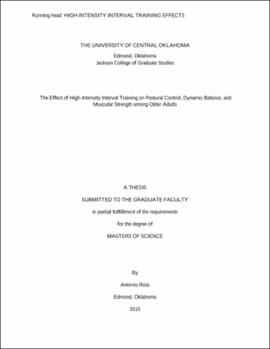| dc.contributor.advisor | Boyd, Larissa | |
| dc.contributor.author | Ross, Antonio | |
| dc.date.accessioned | 2020-07-13T18:52:34Z | |
| dc.date.available | 2020-07-13T18:52:34Z | |
| dc.date.issued | 2015 | |
| dc.identifier.other | (AlmaMMSId)9982436281302196 | |
| dc.identifier.uri | https://hdl.handle.net/11244/325223 | |
| dc.description.abstract | Aging adults are at an increased risk of falling, dependency, and disability due to a decline in physical conditioning. Research has determined muscle weakness and poor balance are associated with these risks. Resistance training may cause muscular strength improvements at any velocity or intensity. High-intensity interval training (HIIT) is an emerging style of fitness, which has shown to be beneficial to muscular strength. PURPOSE: To determine the effects of HIIT on postural sway, dynamic balance, and lower body strength among active older adults. METHODS: The experimental group (EG) participated in the intervention two times per week for 4-weeks. The control group (CG) continued their current fitness routine. HIIT participants utilized exercises which simulated muscle groups that influence balance. Participants completed interval bouts ranging from 20-30s accompanied by a 30 - 40s recovery phase. Participants were assessed on postural sway in tandem, semi-tandem, and single leg stances performed on the TekscanTM pressure mat. Each stance was performed with eyes-open (EO) and eyes-closed (EC). Dynamic balance was measured with the Timed-Up-and-Go (TUG), and lower extremity strength was measured with the 30-Second Chair Stand test. The Wilcoxon Sum of Ranks and Mann-Whitney U tests were used to determined differences within and between groups, respectively. RESULTS: Postural sway significantly improved during eyes open stances (p < 0.05). The experimental group did show a moderate to strong (d >.30) reduction in sway in four different EO stances. The EC stances in the EG showed three significant improvements (p > 0.05). The EG experienced significant improvements in the TUG (p =.04) and approached significant increases in chair stand performance (p =.07). CONCLUSION: HIIT significantly improved dynamic balance and muscular strength, and meaningfully improved postural sway. Future research should utilize HIIT for a longer duration to examine its effects. | |
| dc.rights | All rights reserved by the author, who has granted UCO Chambers Library the non-exclusive right to share this material in its online repositories. Contact UCO Chambers Library's Digital Initiatives Working Group at diwg@uco.edu for the permission policy on the use, reproduction or distribution of this material. | |
| dc.subject.lcsh | Adulthood | |
| dc.subject.lcsh | Applied kinesiology | |
| dc.subject.lcsh | Muscle strength | |
| dc.title | The effects of high-intensity interval training on postural control, dynamic balance, and muscular strength among older adults. | |
| dc.type | Academic theses | |
| dc.contributor.committeeMember | Olson, Jacilyn | |
| dc.contributor.committeeMember | Reed, Douglas | |
| dc.thesis.degree | M.S., Kinesiology and Health Studies | |
| dc.subject.keywords | Balance | |
| dc.subject.keywords | Dynamic Balance | |
| dc.subject.keywords | Fall Prevention | |
| dc.subject.keywords | High-Intensity Interval Training | |
| dc.subject.keywords | Lower Body Strength | |
| dc.subject.keywords | Postural Sway | |
| dc.identifier.oclc | (OCoLC)ocn944246807 | |
| uco.group | UCO - Graduate Works and Theses::UCO - Theses | |
| thesis.degree.grantor | Jackson College of Graduate Studies | |
